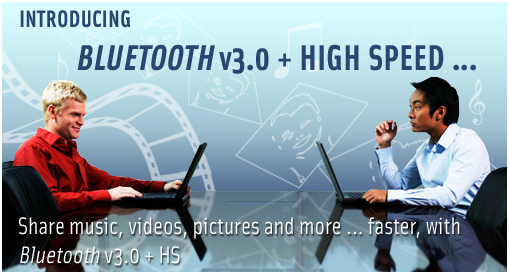Get ready for Bluetooth 3.0

Unless you've been living under a rock, you're fully aware of Bluetooth, that little radio that lets you talk hands-free, stream music, transfer files and a host of other cool things.
If you buy a Windows phone today, chances are it'll have Bluetooth 2.0 + EDR (enhanced data rate), which has a transfer rate of 3 Mbits/second.
Now we're ready for the next standard, and Bluetooth 3.0 has been announced. If the bottom line's your thing, Try 24 Mbits/second transfer rates, thanks to the introduction of the 802.11 standard, which was all know as WiFi.
Things get technical from there, so we'll let you hash out the rest after the break, along with a video of Bluetooth 3.0 in action, thanks to the kids at Engadget.
Anyone want to guess who's going to have the first BT 3.0-enabled phone?
TOKYO – April 22, 2009 – From its annual All Hands Meeting in Tokyo this week, the Bluetooth SIG formally adopted Bluetooth Core Specification Version 3.0 High Speed (HS), or Bluetooth 3.0. This latest iteration of the popular short-range wireless technology fulfills the consumers’ need for speed while providing the same wireless Bluetooth experience – faster. Manufacturers of consumer electronics and home entertainment devices can now build their products to send large amounts of video, music and photos between devices wirelessly at speeds consumers expect.
Bluetooth 3.0 gets its speed from the 802.11 radio protocol. The inclusion of the 802.11 Protocol Adaptation Layer (PAL) provides increased throughput of data transfers at the approximate rate of 24 Mbps. In addition, mobile devices including Bluetooth 3.0 will realize increased power savings due to enhanced power control built in.
Get the Windows Central Newsletter
All the latest news, reviews, and guides for Windows and Xbox diehards.
“Like Ricky Bobby in Talladega Nights, this latest version was ‘born to go fast,’ said Michael Foley, Ph.D., executive director of the Bluetooth SIG. ”Utilizing the 802.11 radio was a natural choice as it provides efficiencies for both our members and consumers – members get more function out of the two radios they are already including in devices, and consumers with Bluetooth v3.0 HS products will get faster exchange of information without changing how they connect. We are excited to expand the possibilities of the PAN.”
This newest version of Bluetooth technology builds on the inherent qualities of the current 2.1 EDR version, including Simple Secure Pairing and built-in, automatic security. And as with all versions of the Bluetooth specification, Bluetooth 3.0 HS provides developers, manufacturers and consumers with the benefit of backwards compatibility, enabling both the expansion and enhancement of this technology with every new specification release. Once products reach the market, the easiest way for consumers to learn which devices are compatible with other Bluetooth enabled devices is to visit the Bluetooth Gadget Guide.
Applications
With the availability of Bluetooth version 3.0 HS, consumers can expect to move large data files of videos, music and photos between their own devices and the trusted devices of others, without the need for cables and wires. Some applications consumers will experience include:
- Wirelessly bulk synchronize music libraries between PC and music player or phone
- Bulk download photos to a printer or PC
- Send video files from camera or phone to computer or television
Availability
The Bluetooth SIG’s formal adoption of the specification is only the first step in the product lifecycle. News out today from wireless chip manufacturers and Bluetooth SIG member companies Atheros, Broadcom, CSR, and Marvell shows the second step – getting silicon solutions to device manufacturers – is already underway. End products for consumers are expected to be in the market in 9 to 12 months.
Technical Specifications
This new specification release includes several major enhancements (learn more here – page requires member login):
- Generic Alternate MAC/PHY (AMP)
- 802.11 Protocol Adaptation Layer (PAL)
- Generic Test Methodology
- Enhanced Power Control
- Unicast Connectionless Data
About Bluetooth® Wireless Technology
Bluetooth wireless technology is the global short-range wireless standard for personal connectivity of a broad range of electronic devices. The technology continues to evolve, building on its inherent strengths – small-form factor radio, low power, low cost, built-in security, robustness, ease-of-use, and ad hoc networking abilities. More than nine new Bluetooth enabled products are qualified every working day and 18 million Bluetooth units are shipping per week. There are over two billion Bluetooth devices in the marketplace and that number climbs daily, making it the only proven wireless choice for developers, product manufacturers, and consumers worldwide.
About the Bluetooth SIG
The Bluetooth Special Interest Group (SIG), comprised of leaders in the telecommunications, computing, consumer electronics, automotive and network industries, is driving development of Bluetooth wireless technology and bringing it to market. The Bluetooth SIG includes Promoter group companies Ericsson, Intel, Lenovo, Microsoft, Motorola, Nokia and Toshiba, along with over 11,000 Associate and Adopter member companies. The Bluetooth SIG, Inc. headquarters are located in Bellevue, Washington, U.S.A. For more information please visit www.bluetooth.com.
Phil is the father of two beautiful girls and is the Dad behind Modern Dad. Before that he spent seven years at the helm of Android Central. Before that he spent a decade in a newsroom of a two-time Pulitzer Prize-finalist newspaper. Before that — well, we don't talk much about those days. Subscribe to the Modern Dad newsletter!
